Academic Study Skills: Portfolio, Research, and Data Analysis
VerifiedAdded on 2023/06/04
|12
|3537
|387
Report
AI Summary
This report provides a comprehensive overview of academic study skills, focusing on portfolio development, evidence-based arguments, and research evaluation. It begins by defining academic portfolios and their components, using Alison's portfolio as an example. The importance of learning incidents is discussed using theoretical models, emphasizing health research and data collection from sources like jurisprudence and statistics. The report identifies relevant sources of evidence for reliable arguments, highlighting authoritative, sourced, objective, and peer-reviewed materials. An annotated bibliography of three sources is included, summarizing findings on skills development, study skills of medical students, and learning-related skills in at-risk children. The distinction between qualitative and quantitative data is examined in the context of a health-related research article, focusing on internal and external validity. The report concludes by emphasizing the relevance of the findings to health and social care practice.
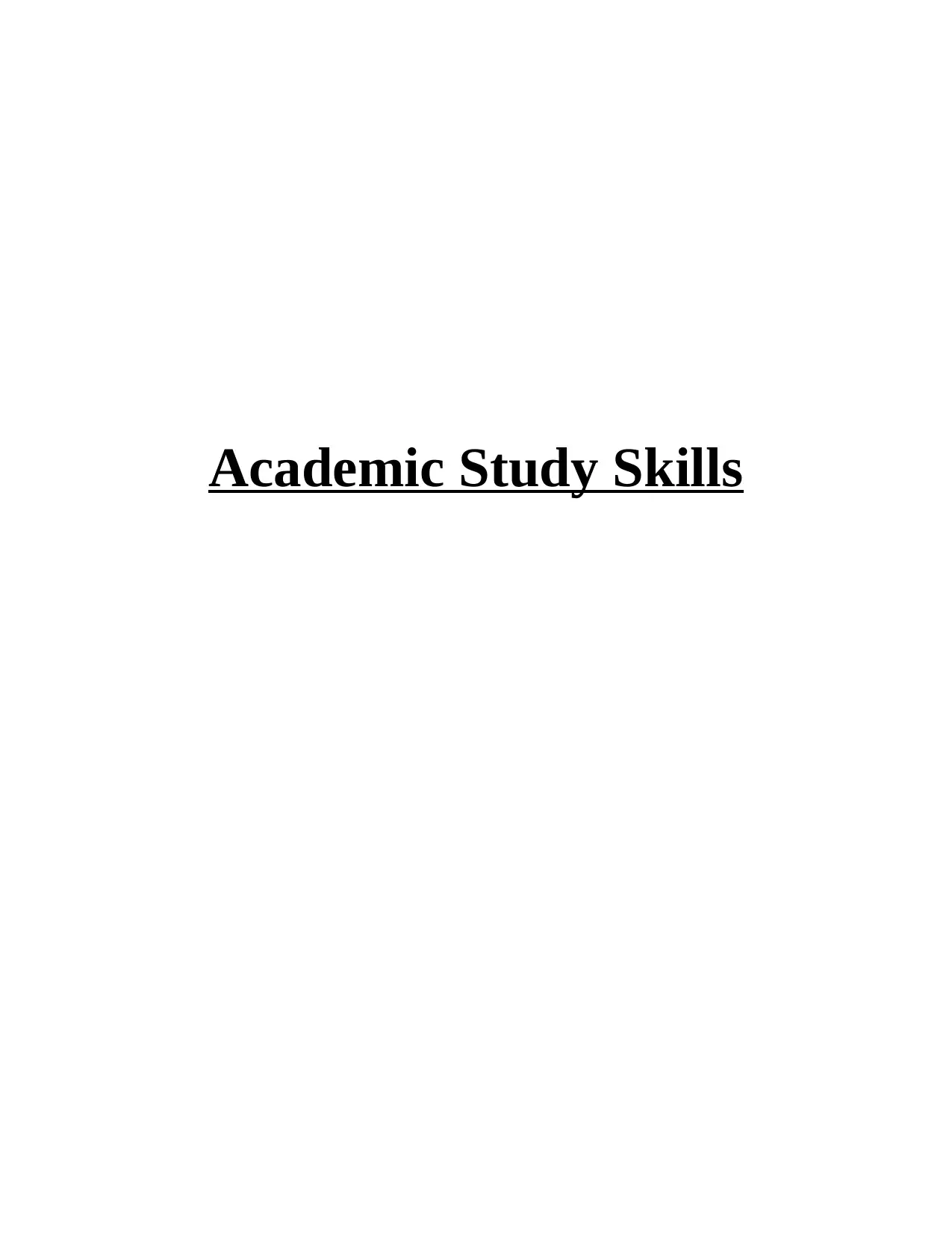
Academic Study Skills
Paraphrase This Document
Need a fresh take? Get an instant paraphrase of this document with our AI Paraphraser
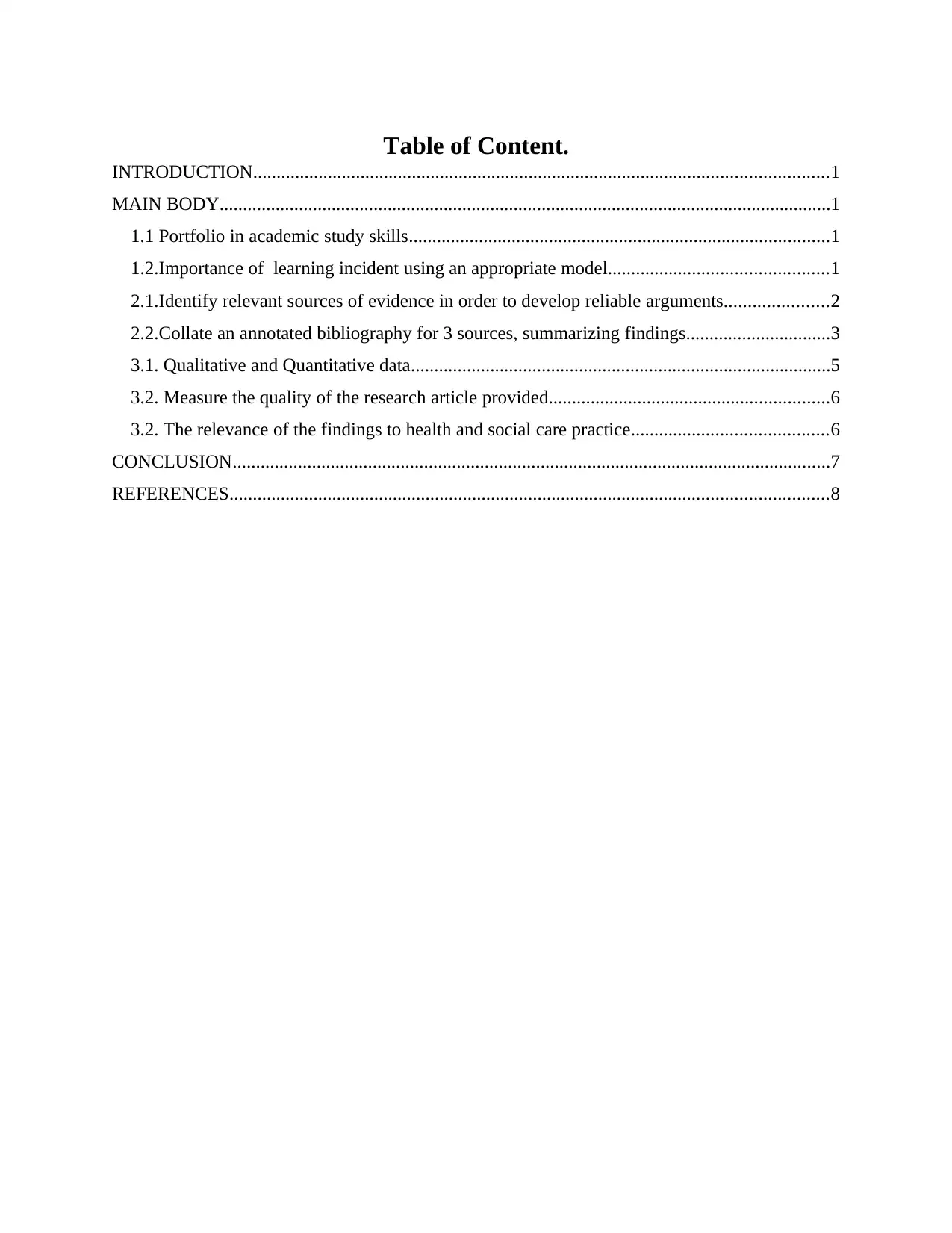
Table of Content.
INTRODUCTION...........................................................................................................................1
MAIN BODY...................................................................................................................................1
1.1 Portfolio in academic study skills..........................................................................................1
1.2.Importance of learning incident using an appropriate model...............................................1
2.1.Identify relevant sources of evidence in order to develop reliable arguments......................2
2.2.Collate an annotated bibliography for 3 sources, summarizing findings...............................3
3.1. Qualitative and Quantitative data..........................................................................................5
3.2. Measure the quality of the research article provided............................................................6
3.2. The relevance of the findings to health and social care practice..........................................6
CONCLUSION................................................................................................................................7
REFERENCES................................................................................................................................8
INTRODUCTION...........................................................................................................................1
MAIN BODY...................................................................................................................................1
1.1 Portfolio in academic study skills..........................................................................................1
1.2.Importance of learning incident using an appropriate model...............................................1
2.1.Identify relevant sources of evidence in order to develop reliable arguments......................2
2.2.Collate an annotated bibliography for 3 sources, summarizing findings...............................3
3.1. Qualitative and Quantitative data..........................................................................................5
3.2. Measure the quality of the research article provided............................................................6
3.2. The relevance of the findings to health and social care practice..........................................6
CONCLUSION................................................................................................................................7
REFERENCES................................................................................................................................8
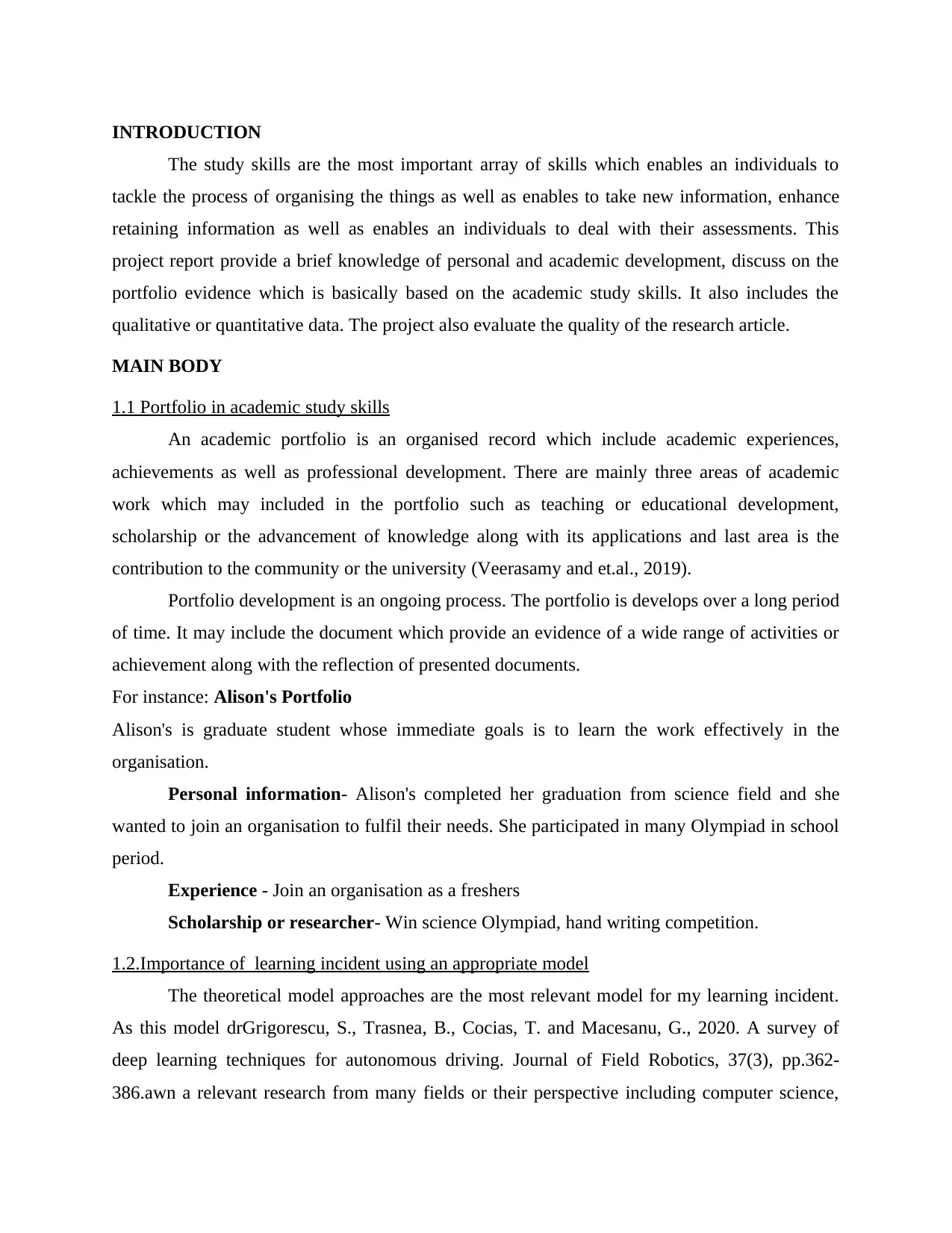
INTRODUCTION
The study skills are the most important array of skills which enables an individuals to
tackle the process of organising the things as well as enables to take new information, enhance
retaining information as well as enables an individuals to deal with their assessments. This
project report provide a brief knowledge of personal and academic development, discuss on the
portfolio evidence which is basically based on the academic study skills. It also includes the
qualitative or quantitative data. The project also evaluate the quality of the research article.
MAIN BODY
1.1 Portfolio in academic study skills
An academic portfolio is an organised record which include academic experiences,
achievements as well as professional development. There are mainly three areas of academic
work which may included in the portfolio such as teaching or educational development,
scholarship or the advancement of knowledge along with its applications and last area is the
contribution to the community or the university (Veerasamy and et.al., 2019).
Portfolio development is an ongoing process. The portfolio is develops over a long period
of time. It may include the document which provide an evidence of a wide range of activities or
achievement along with the reflection of presented documents.
For instance: Alison's Portfolio
Alison's is graduate student whose immediate goals is to learn the work effectively in the
organisation.
Personal information- Alison's completed her graduation from science field and she
wanted to join an organisation to fulfil their needs. She participated in many Olympiad in school
period.
Experience - Join an organisation as a freshers
Scholarship or researcher- Win science Olympiad, hand writing competition.
1.2.Importance of learning incident using an appropriate model
The theoretical model approaches are the most relevant model for my learning incident.
As this model drGrigorescu, S., Trasnea, B., Cocias, T. and Macesanu, G., 2020. A survey of
deep learning techniques for autonomous driving. Journal of Field Robotics, 37(3), pp.362-
386.awn a relevant research from many fields or their perspective including computer science,
The study skills are the most important array of skills which enables an individuals to
tackle the process of organising the things as well as enables to take new information, enhance
retaining information as well as enables an individuals to deal with their assessments. This
project report provide a brief knowledge of personal and academic development, discuss on the
portfolio evidence which is basically based on the academic study skills. It also includes the
qualitative or quantitative data. The project also evaluate the quality of the research article.
MAIN BODY
1.1 Portfolio in academic study skills
An academic portfolio is an organised record which include academic experiences,
achievements as well as professional development. There are mainly three areas of academic
work which may included in the portfolio such as teaching or educational development,
scholarship or the advancement of knowledge along with its applications and last area is the
contribution to the community or the university (Veerasamy and et.al., 2019).
Portfolio development is an ongoing process. The portfolio is develops over a long period
of time. It may include the document which provide an evidence of a wide range of activities or
achievement along with the reflection of presented documents.
For instance: Alison's Portfolio
Alison's is graduate student whose immediate goals is to learn the work effectively in the
organisation.
Personal information- Alison's completed her graduation from science field and she
wanted to join an organisation to fulfil their needs. She participated in many Olympiad in school
period.
Experience - Join an organisation as a freshers
Scholarship or researcher- Win science Olympiad, hand writing competition.
1.2.Importance of learning incident using an appropriate model
The theoretical model approaches are the most relevant model for my learning incident.
As this model drGrigorescu, S., Trasnea, B., Cocias, T. and Macesanu, G., 2020. A survey of
deep learning techniques for autonomous driving. Journal of Field Robotics, 37(3), pp.362-
386.awn a relevant research from many fields or their perspective including computer science,
⊘ This is a preview!⊘
Do you want full access?
Subscribe today to unlock all pages.

Trusted by 1+ million students worldwide
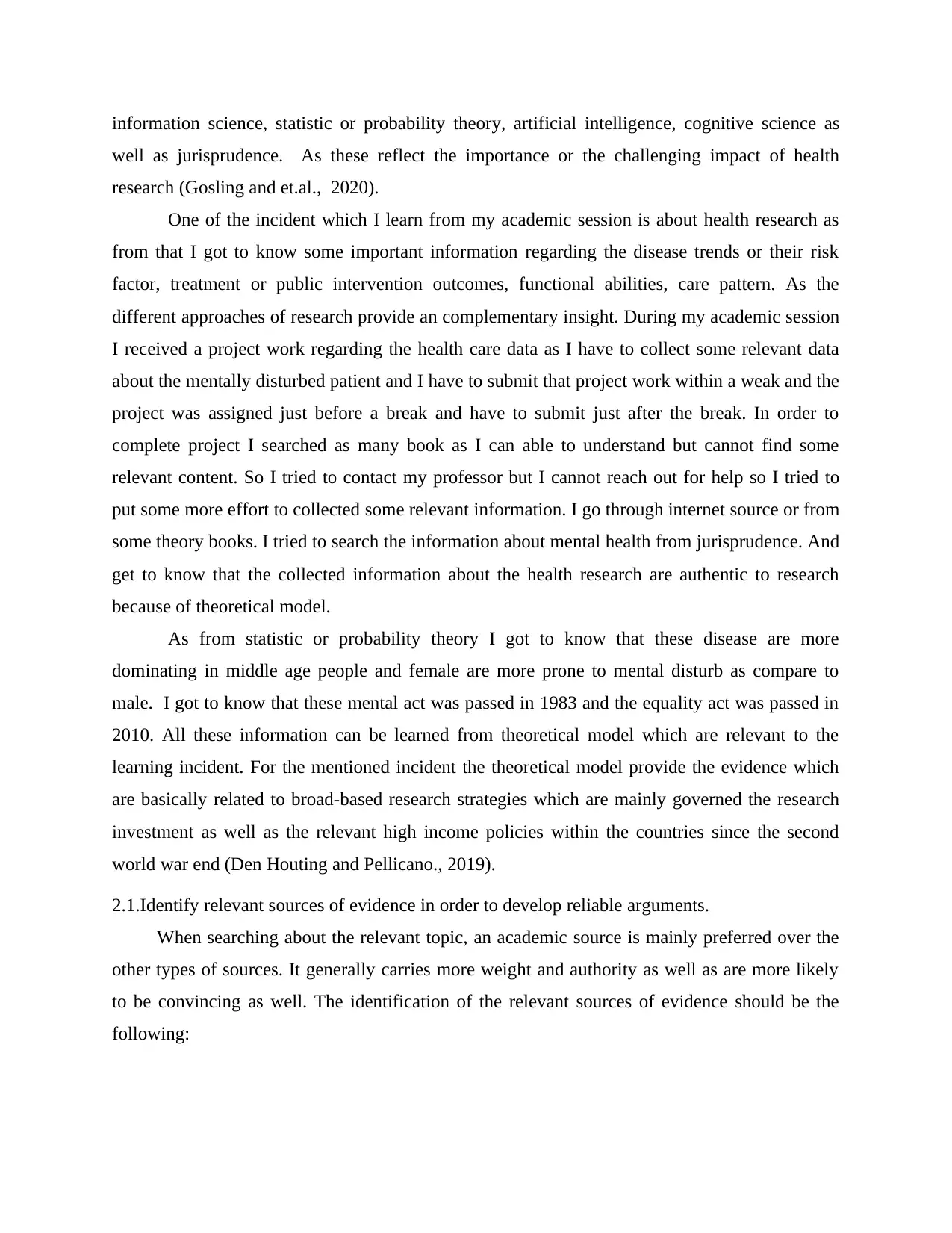
information science, statistic or probability theory, artificial intelligence, cognitive science as
well as jurisprudence. As these reflect the importance or the challenging impact of health
research (Gosling and et.al., 2020).
One of the incident which I learn from my academic session is about health research as
from that I got to know some important information regarding the disease trends or their risk
factor, treatment or public intervention outcomes, functional abilities, care pattern. As the
different approaches of research provide an complementary insight. During my academic session
I received a project work regarding the health care data as I have to collect some relevant data
about the mentally disturbed patient and I have to submit that project work within a weak and the
project was assigned just before a break and have to submit just after the break. In order to
complete project I searched as many book as I can able to understand but cannot find some
relevant content. So I tried to contact my professor but I cannot reach out for help so I tried to
put some more effort to collected some relevant information. I go through internet source or from
some theory books. I tried to search the information about mental health from jurisprudence. And
get to know that the collected information about the health research are authentic to research
because of theoretical model.
As from statistic or probability theory I got to know that these disease are more
dominating in middle age people and female are more prone to mental disturb as compare to
male. I got to know that these mental act was passed in 1983 and the equality act was passed in
2010. All these information can be learned from theoretical model which are relevant to the
learning incident. For the mentioned incident the theoretical model provide the evidence which
are basically related to broad-based research strategies which are mainly governed the research
investment as well as the relevant high income policies within the countries since the second
world war end (Den Houting and Pellicano., 2019).
2.1.Identify relevant sources of evidence in order to develop reliable arguments.
When searching about the relevant topic, an academic source is mainly preferred over the
other types of sources. It generally carries more weight and authority as well as are more likely
to be convincing as well. The identification of the relevant sources of evidence should be the
following:
well as jurisprudence. As these reflect the importance or the challenging impact of health
research (Gosling and et.al., 2020).
One of the incident which I learn from my academic session is about health research as
from that I got to know some important information regarding the disease trends or their risk
factor, treatment or public intervention outcomes, functional abilities, care pattern. As the
different approaches of research provide an complementary insight. During my academic session
I received a project work regarding the health care data as I have to collect some relevant data
about the mentally disturbed patient and I have to submit that project work within a weak and the
project was assigned just before a break and have to submit just after the break. In order to
complete project I searched as many book as I can able to understand but cannot find some
relevant content. So I tried to contact my professor but I cannot reach out for help so I tried to
put some more effort to collected some relevant information. I go through internet source or from
some theory books. I tried to search the information about mental health from jurisprudence. And
get to know that the collected information about the health research are authentic to research
because of theoretical model.
As from statistic or probability theory I got to know that these disease are more
dominating in middle age people and female are more prone to mental disturb as compare to
male. I got to know that these mental act was passed in 1983 and the equality act was passed in
2010. All these information can be learned from theoretical model which are relevant to the
learning incident. For the mentioned incident the theoretical model provide the evidence which
are basically related to broad-based research strategies which are mainly governed the research
investment as well as the relevant high income policies within the countries since the second
world war end (Den Houting and Pellicano., 2019).
2.1.Identify relevant sources of evidence in order to develop reliable arguments.
When searching about the relevant topic, an academic source is mainly preferred over the
other types of sources. It generally carries more weight and authority as well as are more likely
to be convincing as well. The identification of the relevant sources of evidence should be the
following:
Paraphrase This Document
Need a fresh take? Get an instant paraphrase of this document with our AI Paraphraser
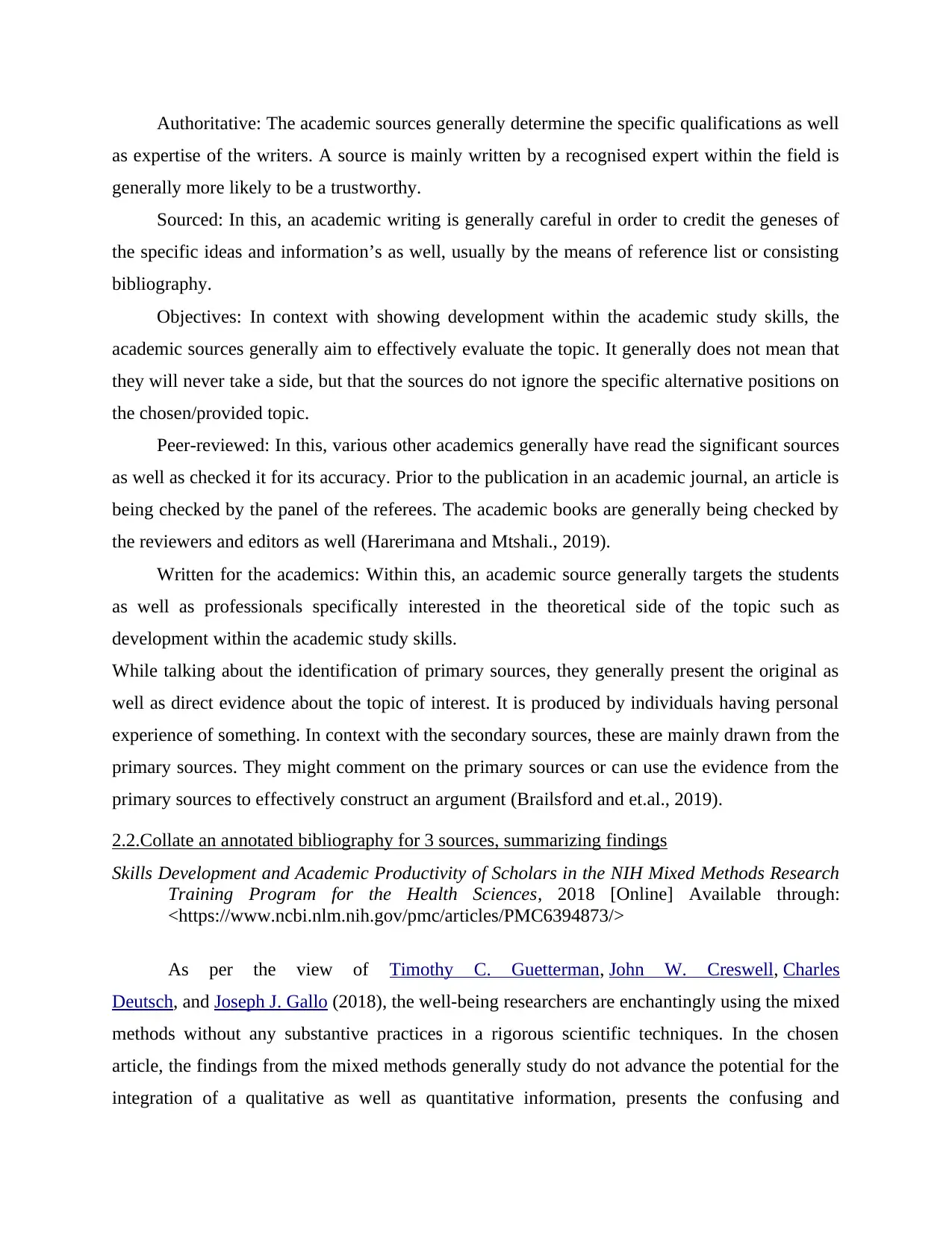
Authoritative: The academic sources generally determine the specific qualifications as well
as expertise of the writers. A source is mainly written by a recognised expert within the field is
generally more likely to be a trustworthy.
Sourced: In this, an academic writing is generally careful in order to credit the geneses of
the specific ideas and information’s as well, usually by the means of reference list or consisting
bibliography.
Objectives: In context with showing development within the academic study skills, the
academic sources generally aim to effectively evaluate the topic. It generally does not mean that
they will never take a side, but that the sources do not ignore the specific alternative positions on
the chosen/provided topic.
Peer-reviewed: In this, various other academics generally have read the significant sources
as well as checked it for its accuracy. Prior to the publication in an academic journal, an article is
being checked by the panel of the referees. The academic books are generally being checked by
the reviewers and editors as well (Harerimana and Mtshali., 2019).
Written for the academics: Within this, an academic source generally targets the students
as well as professionals specifically interested in the theoretical side of the topic such as
development within the academic study skills.
While talking about the identification of primary sources, they generally present the original as
well as direct evidence about the topic of interest. It is produced by individuals having personal
experience of something. In context with the secondary sources, these are mainly drawn from the
primary sources. They might comment on the primary sources or can use the evidence from the
primary sources to effectively construct an argument (Brailsford and et.al., 2019).
2.2.Collate an annotated bibliography for 3 sources, summarizing findings
Skills Development and Academic Productivity of Scholars in the NIH Mixed Methods Research
Training Program for the Health Sciences, 2018 [Online] Available through:
<https://www.ncbi.nlm.nih.gov/pmc/articles/PMC6394873/>
As per the view of Timothy C. Guetterman, John W. Creswell, Charles
Deutsch, and Joseph J. Gallo (2018), the well-being researchers are enchantingly using the mixed
methods without any substantive practices in a rigorous scientific techniques. In the chosen
article, the findings from the mixed methods generally study do not advance the potential for the
integration of a qualitative as well as quantitative information, presents the confusing and
as expertise of the writers. A source is mainly written by a recognised expert within the field is
generally more likely to be a trustworthy.
Sourced: In this, an academic writing is generally careful in order to credit the geneses of
the specific ideas and information’s as well, usually by the means of reference list or consisting
bibliography.
Objectives: In context with showing development within the academic study skills, the
academic sources generally aim to effectively evaluate the topic. It generally does not mean that
they will never take a side, but that the sources do not ignore the specific alternative positions on
the chosen/provided topic.
Peer-reviewed: In this, various other academics generally have read the significant sources
as well as checked it for its accuracy. Prior to the publication in an academic journal, an article is
being checked by the panel of the referees. The academic books are generally being checked by
the reviewers and editors as well (Harerimana and Mtshali., 2019).
Written for the academics: Within this, an academic source generally targets the students
as well as professionals specifically interested in the theoretical side of the topic such as
development within the academic study skills.
While talking about the identification of primary sources, they generally present the original as
well as direct evidence about the topic of interest. It is produced by individuals having personal
experience of something. In context with the secondary sources, these are mainly drawn from the
primary sources. They might comment on the primary sources or can use the evidence from the
primary sources to effectively construct an argument (Brailsford and et.al., 2019).
2.2.Collate an annotated bibliography for 3 sources, summarizing findings
Skills Development and Academic Productivity of Scholars in the NIH Mixed Methods Research
Training Program for the Health Sciences, 2018 [Online] Available through:
<https://www.ncbi.nlm.nih.gov/pmc/articles/PMC6394873/>
As per the view of Timothy C. Guetterman, John W. Creswell, Charles
Deutsch, and Joseph J. Gallo (2018), the well-being researchers are enchantingly using the mixed
methods without any substantive practices in a rigorous scientific techniques. In the chosen
article, the findings from the mixed methods generally study do not advance the potential for the
integration of a qualitative as well as quantitative information, presents the confusing and
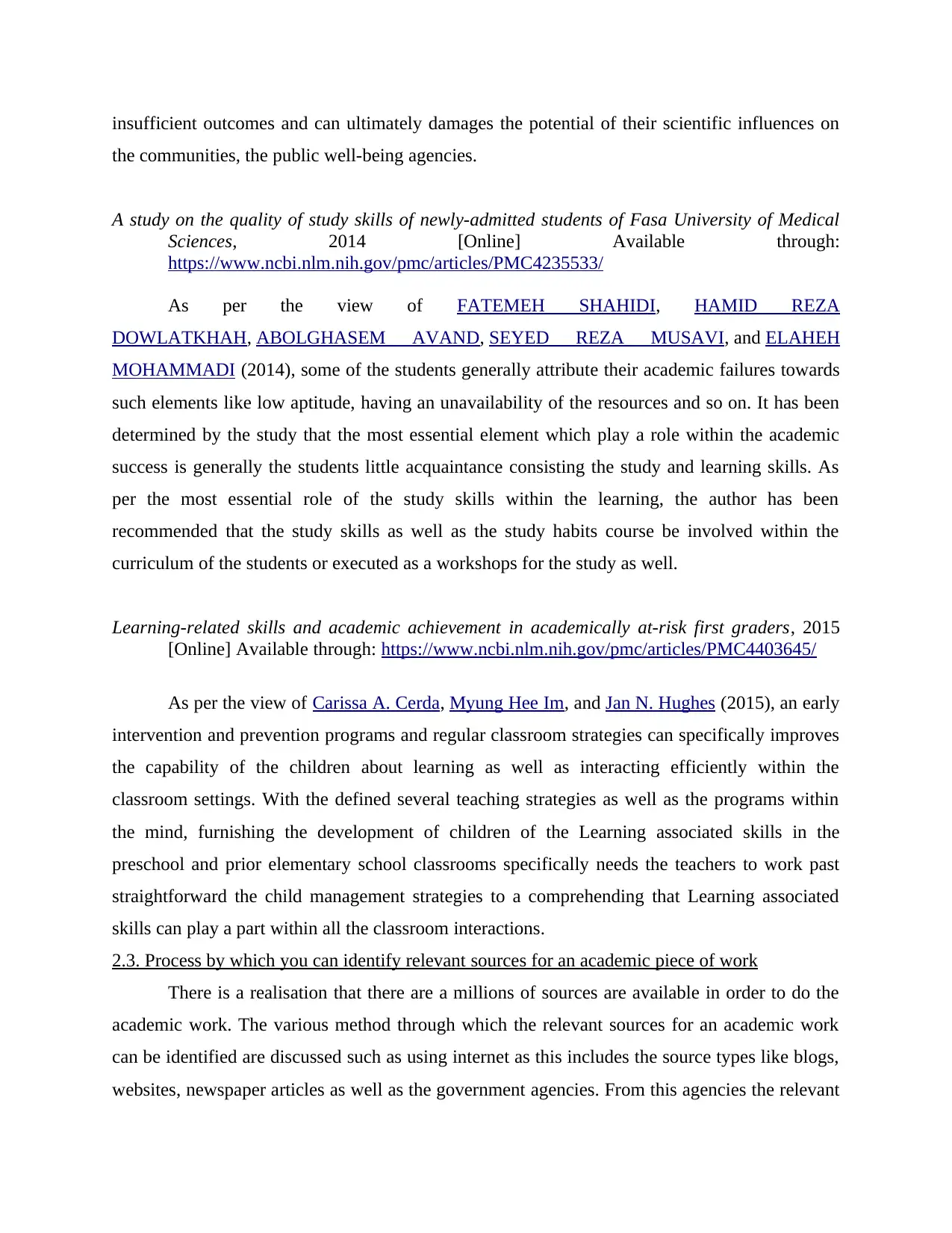
insufficient outcomes and can ultimately damages the potential of their scientific influences on
the communities, the public well-being agencies.
A study on the quality of study skills of newly-admitted students of Fasa University of Medical
Sciences, 2014 [Online] Available through:
https://www.ncbi.nlm.nih.gov/pmc/articles/PMC4235533/
As per the view of FATEMEH SHAHIDI, HAMID REZA
DOWLATKHAH, ABOLGHASEM AVAND, SEYED REZA MUSAVI, and ELAHEH
MOHAMMADI (2014), some of the students generally attribute their academic failures towards
such elements like low aptitude, having an unavailability of the resources and so on. It has been
determined by the study that the most essential element which play a role within the academic
success is generally the students little acquaintance consisting the study and learning skills. As
per the most essential role of the study skills within the learning, the author has been
recommended that the study skills as well as the study habits course be involved within the
curriculum of the students or executed as a workshops for the study as well.
Learning-related skills and academic achievement in academically at-risk first graders, 2015
[Online] Available through: https://www.ncbi.nlm.nih.gov/pmc/articles/PMC4403645/
As per the view of Carissa A. Cerda, Myung Hee Im, and Jan N. Hughes (2015), an early
intervention and prevention programs and regular classroom strategies can specifically improves
the capability of the children about learning as well as interacting efficiently within the
classroom settings. With the defined several teaching strategies as well as the programs within
the mind, furnishing the development of children of the Learning associated skills in the
preschool and prior elementary school classrooms specifically needs the teachers to work past
straightforward the child management strategies to a comprehending that Learning associated
skills can play a part within all the classroom interactions.
2.3. Process by which you can identify relevant sources for an academic piece of work
There is a realisation that there are a millions of sources are available in order to do the
academic work. The various method through which the relevant sources for an academic work
can be identified are discussed such as using internet as this includes the source types like blogs,
websites, newspaper articles as well as the government agencies. From this agencies the relevant
the communities, the public well-being agencies.
A study on the quality of study skills of newly-admitted students of Fasa University of Medical
Sciences, 2014 [Online] Available through:
https://www.ncbi.nlm.nih.gov/pmc/articles/PMC4235533/
As per the view of FATEMEH SHAHIDI, HAMID REZA
DOWLATKHAH, ABOLGHASEM AVAND, SEYED REZA MUSAVI, and ELAHEH
MOHAMMADI (2014), some of the students generally attribute their academic failures towards
such elements like low aptitude, having an unavailability of the resources and so on. It has been
determined by the study that the most essential element which play a role within the academic
success is generally the students little acquaintance consisting the study and learning skills. As
per the most essential role of the study skills within the learning, the author has been
recommended that the study skills as well as the study habits course be involved within the
curriculum of the students or executed as a workshops for the study as well.
Learning-related skills and academic achievement in academically at-risk first graders, 2015
[Online] Available through: https://www.ncbi.nlm.nih.gov/pmc/articles/PMC4403645/
As per the view of Carissa A. Cerda, Myung Hee Im, and Jan N. Hughes (2015), an early
intervention and prevention programs and regular classroom strategies can specifically improves
the capability of the children about learning as well as interacting efficiently within the
classroom settings. With the defined several teaching strategies as well as the programs within
the mind, furnishing the development of children of the Learning associated skills in the
preschool and prior elementary school classrooms specifically needs the teachers to work past
straightforward the child management strategies to a comprehending that Learning associated
skills can play a part within all the classroom interactions.
2.3. Process by which you can identify relevant sources for an academic piece of work
There is a realisation that there are a millions of sources are available in order to do the
academic work. The various method through which the relevant sources for an academic work
can be identified are discussed such as using internet as this includes the source types like blogs,
websites, newspaper articles as well as the government agencies. From this agencies the relevant
⊘ This is a preview!⊘
Do you want full access?
Subscribe today to unlock all pages.

Trusted by 1+ million students worldwide
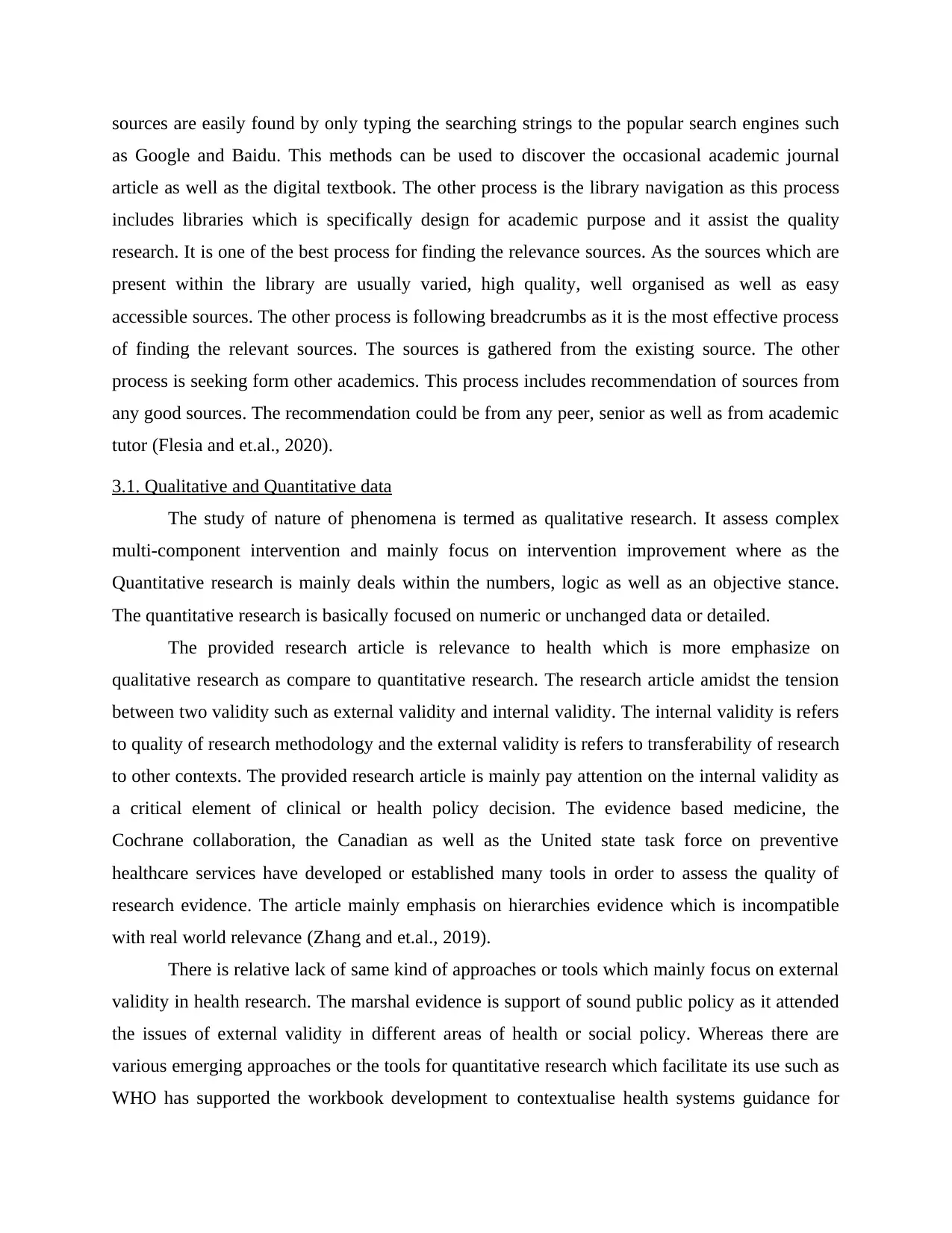
sources are easily found by only typing the searching strings to the popular search engines such
as Google and Baidu. This methods can be used to discover the occasional academic journal
article as well as the digital textbook. The other process is the library navigation as this process
includes libraries which is specifically design for academic purpose and it assist the quality
research. It is one of the best process for finding the relevance sources. As the sources which are
present within the library are usually varied, high quality, well organised as well as easy
accessible sources. The other process is following breadcrumbs as it is the most effective process
of finding the relevant sources. The sources is gathered from the existing source. The other
process is seeking form other academics. This process includes recommendation of sources from
any good sources. The recommendation could be from any peer, senior as well as from academic
tutor (Flesia and et.al., 2020).
3.1. Qualitative and Quantitative data
The study of nature of phenomena is termed as qualitative research. It assess complex
multi-component intervention and mainly focus on intervention improvement where as the
Quantitative research is mainly deals within the numbers, logic as well as an objective stance.
The quantitative research is basically focused on numeric or unchanged data or detailed.
The provided research article is relevance to health which is more emphasize on
qualitative research as compare to quantitative research. The research article amidst the tension
between two validity such as external validity and internal validity. The internal validity is refers
to quality of research methodology and the external validity is refers to transferability of research
to other contexts. The provided research article is mainly pay attention on the internal validity as
a critical element of clinical or health policy decision. The evidence based medicine, the
Cochrane collaboration, the Canadian as well as the United state task force on preventive
healthcare services have developed or established many tools in order to assess the quality of
research evidence. The article mainly emphasis on hierarchies evidence which is incompatible
with real world relevance (Zhang and et.al., 2019).
There is relative lack of same kind of approaches or tools which mainly focus on external
validity in health research. The marshal evidence is support of sound public policy as it attended
the issues of external validity in different areas of health or social policy. Whereas there are
various emerging approaches or the tools for quantitative research which facilitate its use such as
WHO has supported the workbook development to contextualise health systems guidance for
as Google and Baidu. This methods can be used to discover the occasional academic journal
article as well as the digital textbook. The other process is the library navigation as this process
includes libraries which is specifically design for academic purpose and it assist the quality
research. It is one of the best process for finding the relevance sources. As the sources which are
present within the library are usually varied, high quality, well organised as well as easy
accessible sources. The other process is following breadcrumbs as it is the most effective process
of finding the relevant sources. The sources is gathered from the existing source. The other
process is seeking form other academics. This process includes recommendation of sources from
any good sources. The recommendation could be from any peer, senior as well as from academic
tutor (Flesia and et.al., 2020).
3.1. Qualitative and Quantitative data
The study of nature of phenomena is termed as qualitative research. It assess complex
multi-component intervention and mainly focus on intervention improvement where as the
Quantitative research is mainly deals within the numbers, logic as well as an objective stance.
The quantitative research is basically focused on numeric or unchanged data or detailed.
The provided research article is relevance to health which is more emphasize on
qualitative research as compare to quantitative research. The research article amidst the tension
between two validity such as external validity and internal validity. The internal validity is refers
to quality of research methodology and the external validity is refers to transferability of research
to other contexts. The provided research article is mainly pay attention on the internal validity as
a critical element of clinical or health policy decision. The evidence based medicine, the
Cochrane collaboration, the Canadian as well as the United state task force on preventive
healthcare services have developed or established many tools in order to assess the quality of
research evidence. The article mainly emphasis on hierarchies evidence which is incompatible
with real world relevance (Zhang and et.al., 2019).
There is relative lack of same kind of approaches or tools which mainly focus on external
validity in health research. The marshal evidence is support of sound public policy as it attended
the issues of external validity in different areas of health or social policy. Whereas there are
various emerging approaches or the tools for quantitative research which facilitate its use such as
WHO has supported the workbook development to contextualise health systems guidance for
Paraphrase This Document
Need a fresh take? Get an instant paraphrase of this document with our AI Paraphraser
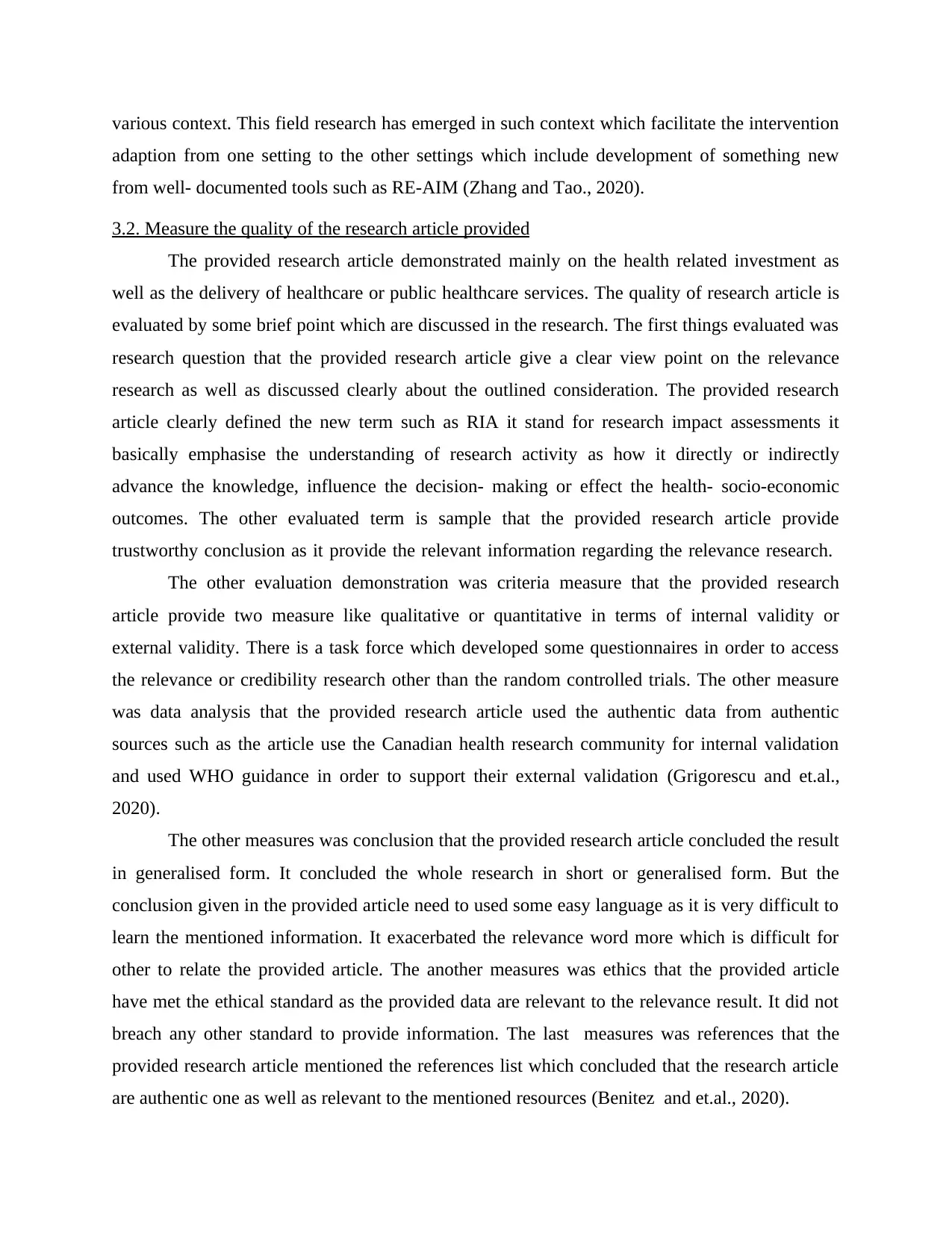
various context. This field research has emerged in such context which facilitate the intervention
adaption from one setting to the other settings which include development of something new
from well- documented tools such as RE-AIM (Zhang and Tao., 2020).
3.2. Measure the quality of the research article provided
The provided research article demonstrated mainly on the health related investment as
well as the delivery of healthcare or public healthcare services. The quality of research article is
evaluated by some brief point which are discussed in the research. The first things evaluated was
research question that the provided research article give a clear view point on the relevance
research as well as discussed clearly about the outlined consideration. The provided research
article clearly defined the new term such as RIA it stand for research impact assessments it
basically emphasise the understanding of research activity as how it directly or indirectly
advance the knowledge, influence the decision- making or effect the health- socio-economic
outcomes. The other evaluated term is sample that the provided research article provide
trustworthy conclusion as it provide the relevant information regarding the relevance research.
The other evaluation demonstration was criteria measure that the provided research
article provide two measure like qualitative or quantitative in terms of internal validity or
external validity. There is a task force which developed some questionnaires in order to access
the relevance or credibility research other than the random controlled trials. The other measure
was data analysis that the provided research article used the authentic data from authentic
sources such as the article use the Canadian health research community for internal validation
and used WHO guidance in order to support their external validation (Grigorescu and et.al.,
2020).
The other measures was conclusion that the provided research article concluded the result
in generalised form. It concluded the whole research in short or generalised form. But the
conclusion given in the provided article need to used some easy language as it is very difficult to
learn the mentioned information. It exacerbated the relevance word more which is difficult for
other to relate the provided article. The another measures was ethics that the provided article
have met the ethical standard as the provided data are relevant to the relevance result. It did not
breach any other standard to provide information. The last measures was references that the
provided research article mentioned the references list which concluded that the research article
are authentic one as well as relevant to the mentioned resources (Benitez and et.al., 2020).
adaption from one setting to the other settings which include development of something new
from well- documented tools such as RE-AIM (Zhang and Tao., 2020).
3.2. Measure the quality of the research article provided
The provided research article demonstrated mainly on the health related investment as
well as the delivery of healthcare or public healthcare services. The quality of research article is
evaluated by some brief point which are discussed in the research. The first things evaluated was
research question that the provided research article give a clear view point on the relevance
research as well as discussed clearly about the outlined consideration. The provided research
article clearly defined the new term such as RIA it stand for research impact assessments it
basically emphasise the understanding of research activity as how it directly or indirectly
advance the knowledge, influence the decision- making or effect the health- socio-economic
outcomes. The other evaluated term is sample that the provided research article provide
trustworthy conclusion as it provide the relevant information regarding the relevance research.
The other evaluation demonstration was criteria measure that the provided research
article provide two measure like qualitative or quantitative in terms of internal validity or
external validity. There is a task force which developed some questionnaires in order to access
the relevance or credibility research other than the random controlled trials. The other measure
was data analysis that the provided research article used the authentic data from authentic
sources such as the article use the Canadian health research community for internal validation
and used WHO guidance in order to support their external validation (Grigorescu and et.al.,
2020).
The other measures was conclusion that the provided research article concluded the result
in generalised form. It concluded the whole research in short or generalised form. But the
conclusion given in the provided article need to used some easy language as it is very difficult to
learn the mentioned information. It exacerbated the relevance word more which is difficult for
other to relate the provided article. The another measures was ethics that the provided article
have met the ethical standard as the provided data are relevant to the relevance result. It did not
breach any other standard to provide information. The last measures was references that the
provided research article mentioned the references list which concluded that the research article
are authentic one as well as relevant to the mentioned resources (Benitez and et.al., 2020).
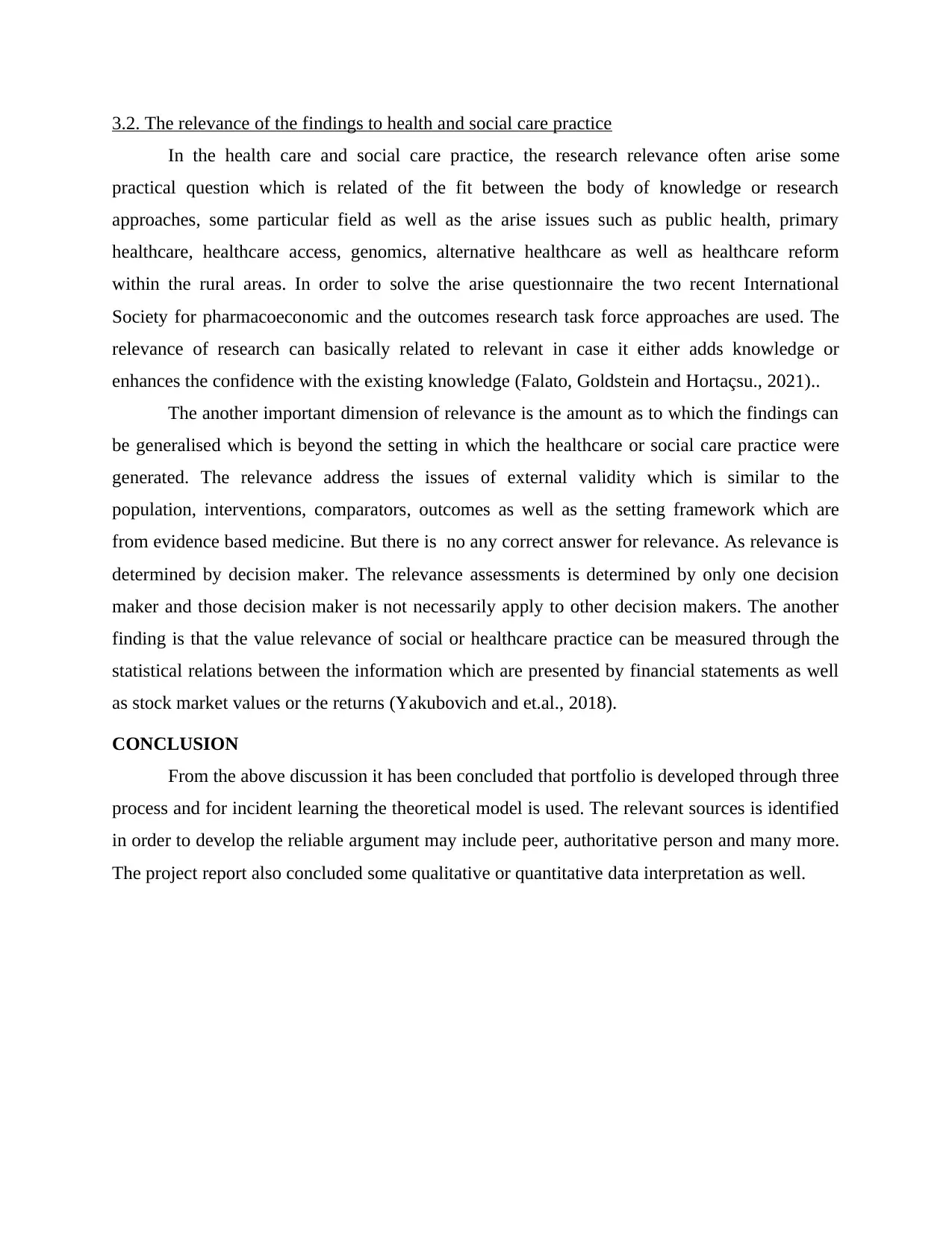
3.2. The relevance of the findings to health and social care practice
In the health care and social care practice, the research relevance often arise some
practical question which is related of the fit between the body of knowledge or research
approaches, some particular field as well as the arise issues such as public health, primary
healthcare, healthcare access, genomics, alternative healthcare as well as healthcare reform
within the rural areas. In order to solve the arise questionnaire the two recent International
Society for pharmacoeconomic and the outcomes research task force approaches are used. The
relevance of research can basically related to relevant in case it either adds knowledge or
enhances the confidence with the existing knowledge (Falato, Goldstein and Hortaçsu., 2021)..
The another important dimension of relevance is the amount as to which the findings can
be generalised which is beyond the setting in which the healthcare or social care practice were
generated. The relevance address the issues of external validity which is similar to the
population, interventions, comparators, outcomes as well as the setting framework which are
from evidence based medicine. But there is no any correct answer for relevance. As relevance is
determined by decision maker. The relevance assessments is determined by only one decision
maker and those decision maker is not necessarily apply to other decision makers. The another
finding is that the value relevance of social or healthcare practice can be measured through the
statistical relations between the information which are presented by financial statements as well
as stock market values or the returns (Yakubovich and et.al., 2018).
CONCLUSION
From the above discussion it has been concluded that portfolio is developed through three
process and for incident learning the theoretical model is used. The relevant sources is identified
in order to develop the reliable argument may include peer, authoritative person and many more.
The project report also concluded some qualitative or quantitative data interpretation as well.
In the health care and social care practice, the research relevance often arise some
practical question which is related of the fit between the body of knowledge or research
approaches, some particular field as well as the arise issues such as public health, primary
healthcare, healthcare access, genomics, alternative healthcare as well as healthcare reform
within the rural areas. In order to solve the arise questionnaire the two recent International
Society for pharmacoeconomic and the outcomes research task force approaches are used. The
relevance of research can basically related to relevant in case it either adds knowledge or
enhances the confidence with the existing knowledge (Falato, Goldstein and Hortaçsu., 2021)..
The another important dimension of relevance is the amount as to which the findings can
be generalised which is beyond the setting in which the healthcare or social care practice were
generated. The relevance address the issues of external validity which is similar to the
population, interventions, comparators, outcomes as well as the setting framework which are
from evidence based medicine. But there is no any correct answer for relevance. As relevance is
determined by decision maker. The relevance assessments is determined by only one decision
maker and those decision maker is not necessarily apply to other decision makers. The another
finding is that the value relevance of social or healthcare practice can be measured through the
statistical relations between the information which are presented by financial statements as well
as stock market values or the returns (Yakubovich and et.al., 2018).
CONCLUSION
From the above discussion it has been concluded that portfolio is developed through three
process and for incident learning the theoretical model is used. The relevant sources is identified
in order to develop the reliable argument may include peer, authoritative person and many more.
The project report also concluded some qualitative or quantitative data interpretation as well.
⊘ This is a preview!⊘
Do you want full access?
Subscribe today to unlock all pages.

Trusted by 1+ million students worldwide

Paraphrase This Document
Need a fresh take? Get an instant paraphrase of this document with our AI Paraphraser
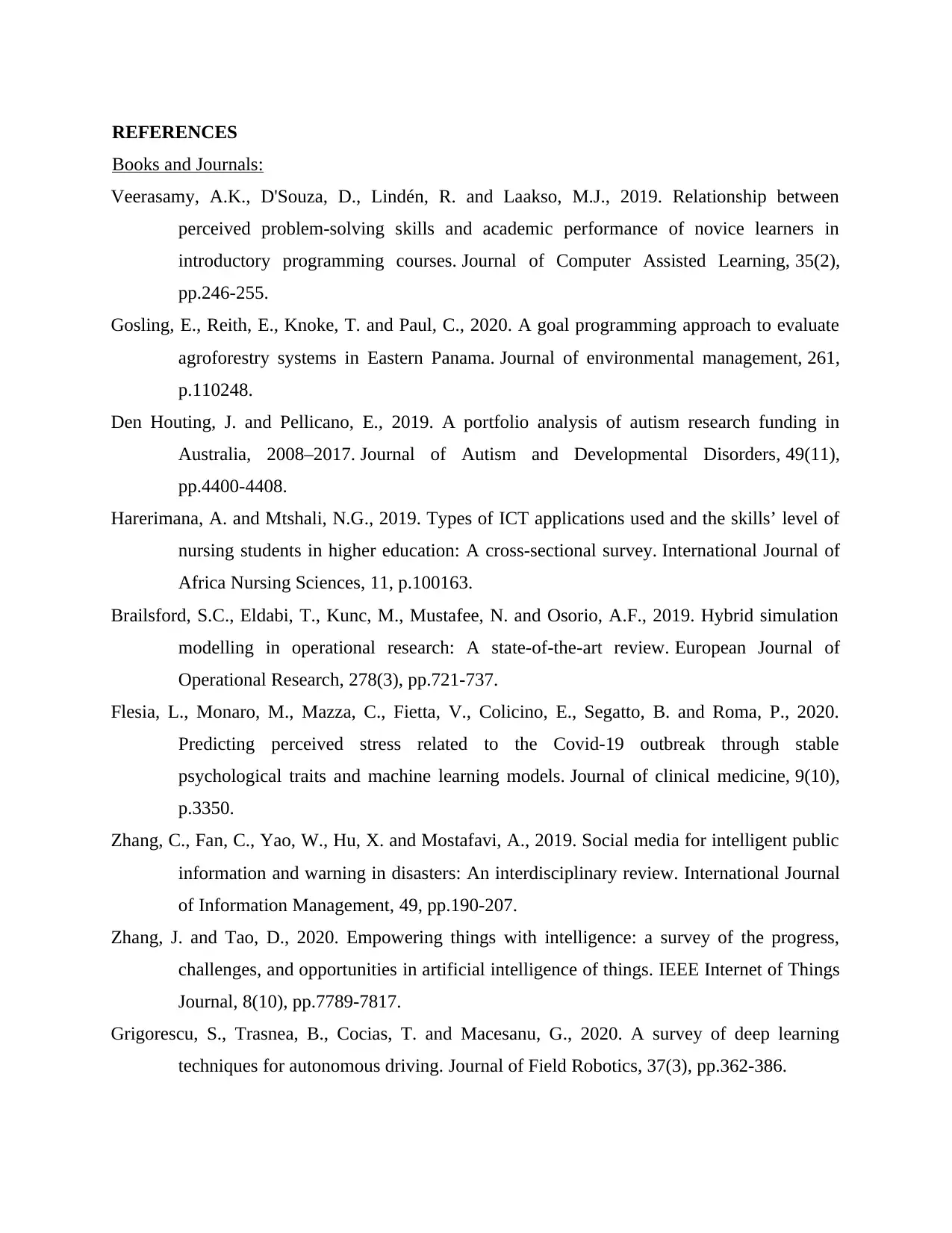
REFERENCES
Books and Journals:
Veerasamy, A.K., D'Souza, D., Lindén, R. and Laakso, M.J., 2019. Relationship between
perceived problem‐solving skills and academic performance of novice learners in
introductory programming courses. Journal of Computer Assisted Learning, 35(2),
pp.246-255.
Gosling, E., Reith, E., Knoke, T. and Paul, C., 2020. A goal programming approach to evaluate
agroforestry systems in Eastern Panama. Journal of environmental management, 261,
p.110248.
Den Houting, J. and Pellicano, E., 2019. A portfolio analysis of autism research funding in
Australia, 2008–2017. Journal of Autism and Developmental Disorders, 49(11),
pp.4400-4408.
Harerimana, A. and Mtshali, N.G., 2019. Types of ICT applications used and the skills’ level of
nursing students in higher education: A cross-sectional survey. International Journal of
Africa Nursing Sciences, 11, p.100163.
Brailsford, S.C., Eldabi, T., Kunc, M., Mustafee, N. and Osorio, A.F., 2019. Hybrid simulation
modelling in operational research: A state-of-the-art review. European Journal of
Operational Research, 278(3), pp.721-737.
Flesia, L., Monaro, M., Mazza, C., Fietta, V., Colicino, E., Segatto, B. and Roma, P., 2020.
Predicting perceived stress related to the Covid-19 outbreak through stable
psychological traits and machine learning models. Journal of clinical medicine, 9(10),
p.3350.
Zhang, C., Fan, C., Yao, W., Hu, X. and Mostafavi, A., 2019. Social media for intelligent public
information and warning in disasters: An interdisciplinary review. International Journal
of Information Management, 49, pp.190-207.
Zhang, J. and Tao, D., 2020. Empowering things with intelligence: a survey of the progress,
challenges, and opportunities in artificial intelligence of things. IEEE Internet of Things
Journal, 8(10), pp.7789-7817.
Grigorescu, S., Trasnea, B., Cocias, T. and Macesanu, G., 2020. A survey of deep learning
techniques for autonomous driving. Journal of Field Robotics, 37(3), pp.362-386.
Books and Journals:
Veerasamy, A.K., D'Souza, D., Lindén, R. and Laakso, M.J., 2019. Relationship between
perceived problem‐solving skills and academic performance of novice learners in
introductory programming courses. Journal of Computer Assisted Learning, 35(2),
pp.246-255.
Gosling, E., Reith, E., Knoke, T. and Paul, C., 2020. A goal programming approach to evaluate
agroforestry systems in Eastern Panama. Journal of environmental management, 261,
p.110248.
Den Houting, J. and Pellicano, E., 2019. A portfolio analysis of autism research funding in
Australia, 2008–2017. Journal of Autism and Developmental Disorders, 49(11),
pp.4400-4408.
Harerimana, A. and Mtshali, N.G., 2019. Types of ICT applications used and the skills’ level of
nursing students in higher education: A cross-sectional survey. International Journal of
Africa Nursing Sciences, 11, p.100163.
Brailsford, S.C., Eldabi, T., Kunc, M., Mustafee, N. and Osorio, A.F., 2019. Hybrid simulation
modelling in operational research: A state-of-the-art review. European Journal of
Operational Research, 278(3), pp.721-737.
Flesia, L., Monaro, M., Mazza, C., Fietta, V., Colicino, E., Segatto, B. and Roma, P., 2020.
Predicting perceived stress related to the Covid-19 outbreak through stable
psychological traits and machine learning models. Journal of clinical medicine, 9(10),
p.3350.
Zhang, C., Fan, C., Yao, W., Hu, X. and Mostafavi, A., 2019. Social media for intelligent public
information and warning in disasters: An interdisciplinary review. International Journal
of Information Management, 49, pp.190-207.
Zhang, J. and Tao, D., 2020. Empowering things with intelligence: a survey of the progress,
challenges, and opportunities in artificial intelligence of things. IEEE Internet of Things
Journal, 8(10), pp.7789-7817.
Grigorescu, S., Trasnea, B., Cocias, T. and Macesanu, G., 2020. A survey of deep learning
techniques for autonomous driving. Journal of Field Robotics, 37(3), pp.362-386.
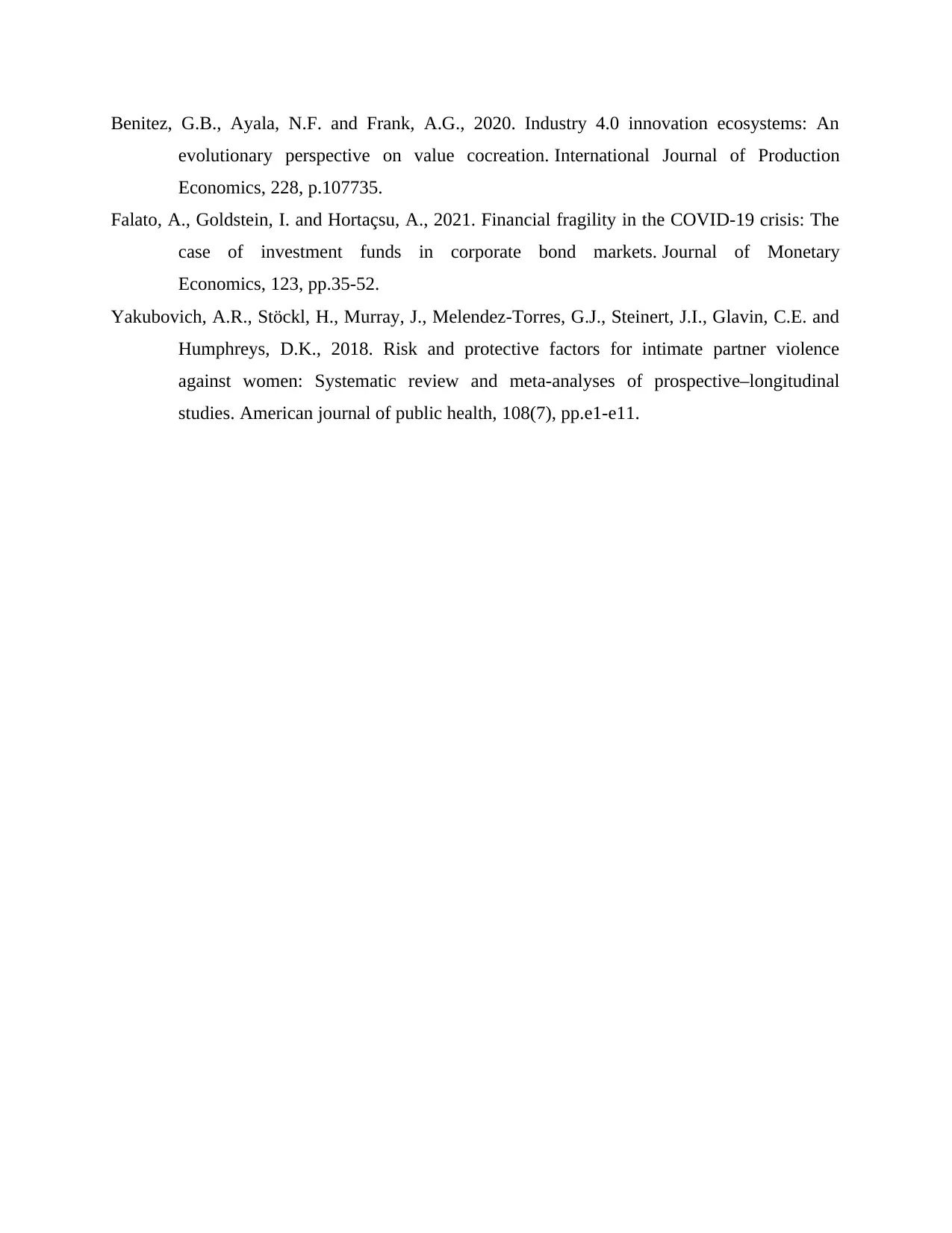
Benitez, G.B., Ayala, N.F. and Frank, A.G., 2020. Industry 4.0 innovation ecosystems: An
evolutionary perspective on value cocreation. International Journal of Production
Economics, 228, p.107735.
Falato, A., Goldstein, I. and Hortaçsu, A., 2021. Financial fragility in the COVID-19 crisis: The
case of investment funds in corporate bond markets. Journal of Monetary
Economics, 123, pp.35-52.
Yakubovich, A.R., Stöckl, H., Murray, J., Melendez-Torres, G.J., Steinert, J.I., Glavin, C.E. and
Humphreys, D.K., 2018. Risk and protective factors for intimate partner violence
against women: Systematic review and meta-analyses of prospective–longitudinal
studies. American journal of public health, 108(7), pp.e1-e11.
evolutionary perspective on value cocreation. International Journal of Production
Economics, 228, p.107735.
Falato, A., Goldstein, I. and Hortaçsu, A., 2021. Financial fragility in the COVID-19 crisis: The
case of investment funds in corporate bond markets. Journal of Monetary
Economics, 123, pp.35-52.
Yakubovich, A.R., Stöckl, H., Murray, J., Melendez-Torres, G.J., Steinert, J.I., Glavin, C.E. and
Humphreys, D.K., 2018. Risk and protective factors for intimate partner violence
against women: Systematic review and meta-analyses of prospective–longitudinal
studies. American journal of public health, 108(7), pp.e1-e11.
⊘ This is a preview!⊘
Do you want full access?
Subscribe today to unlock all pages.

Trusted by 1+ million students worldwide
1 out of 12
Related Documents
Your All-in-One AI-Powered Toolkit for Academic Success.
+13062052269
info@desklib.com
Available 24*7 on WhatsApp / Email
![[object Object]](/_next/static/media/star-bottom.7253800d.svg)
Unlock your academic potential
Copyright © 2020–2025 A2Z Services. All Rights Reserved. Developed and managed by ZUCOL.




